• The Buffalo Bills bench Keon Coleman: The Bills rookie wide receiver went from the top of the depth chart to the fourth spot with no warning, but he also scored his first NFL touchdown.
• Tee Higgins returns: The star wide receiver missed the first two weeks but was back for this game and was not on a snap count.
• Unlock your edge with a PFF+ subscription: Get full access to all of our in-season fantasy tools, including weekly rankings, WR/CB matchup charts, weekly projections, the Start-Sit Optimizer and more. Sign up now!
Estimated Reading Time: 10 minutes
PFF's fantasy football recap focuses on player usage and stats, breaking down all the vital information you need to achieve fantasy success in 2024.
Jacksonville Jaguars @ Buffalo Bills
- Khalil Shakir: 6 receptions, 72 yards, 1 touchdown
- James Cook: 11 carries, 39 yards, 1 touchdown, 4 receptions, 48 receiving yards
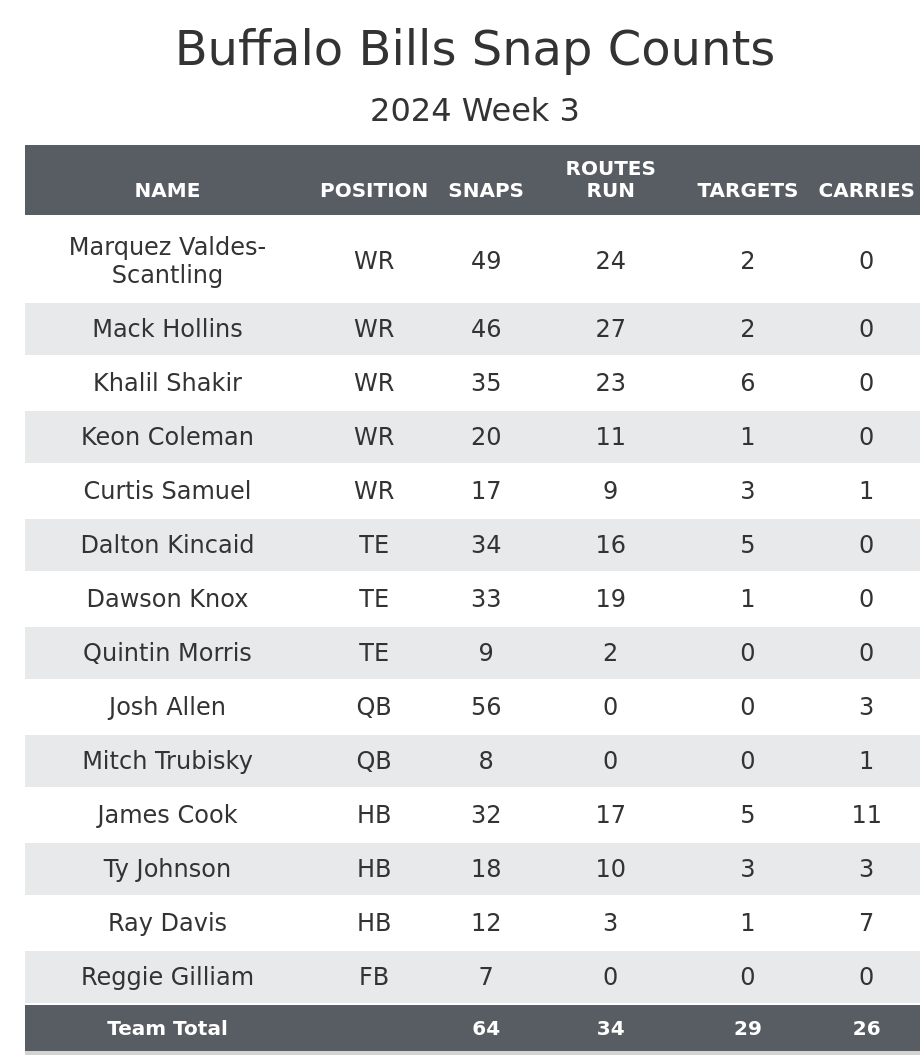
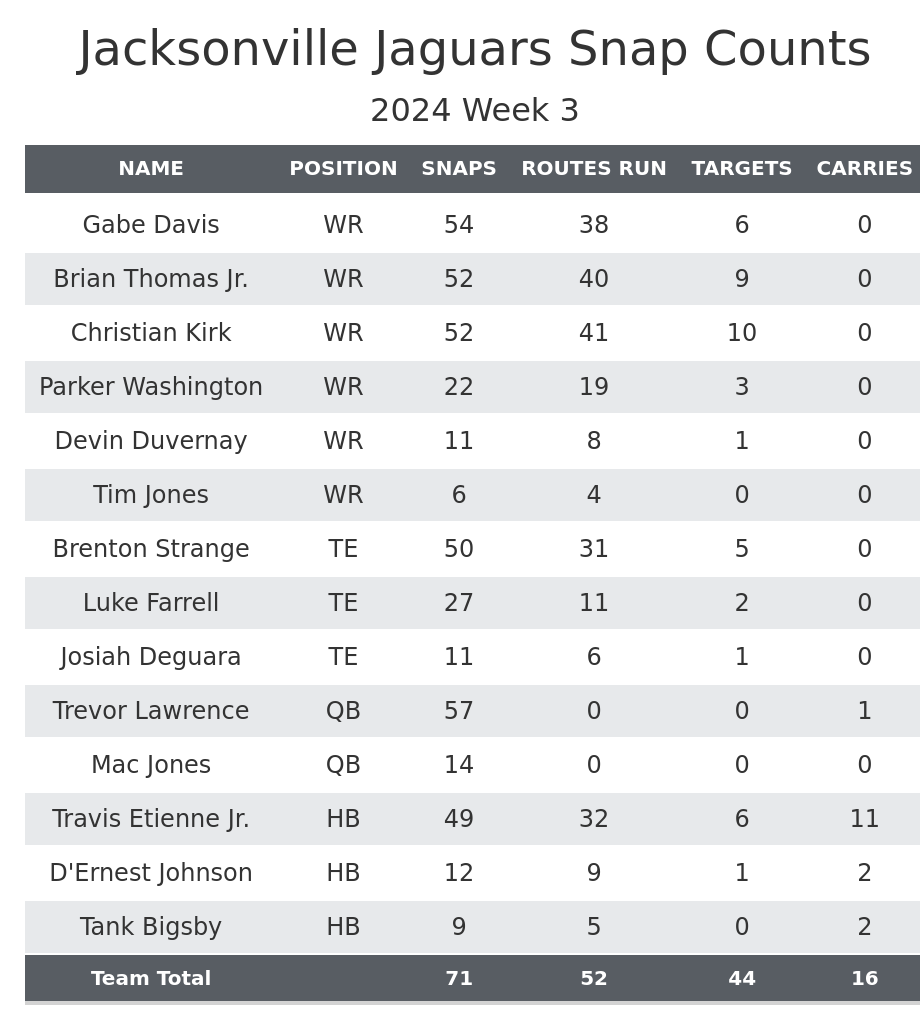
The Bills benched Keon Coleman: Coleman didn’t see a single snap on the Bills’ first two drives.
Coleman spent the first two weeks playing the most offensive snaps for the Bills and running the most routes. Last week, he played more than 90% of offensive snaps.
On the first two drives, Khalil Shakir played more often than usual in two-wide receiver sets, while Marquez Valdes-Scantling replaced Coleman as the outside receiver in three-receiver sets. This game was good news for Shakir — both the increased playing time early and the good stat line. He barely played in the second half because the Bills mostly used backup wide receivers. It was clear Valdes-Scantling was the backup outside receiver in the preseason, and he played 16 of a possible 106 snaps in the first two games.
While this obviously isn’t great for Coleman, it also wasn’t good for Curtis Samuel. Samuel played only eight of 23 snaps on those first two drives, and it showed that even if Coleman or Mack Hollins suffered an injury at some point this season, Samuel still wouldn’t be seeing enough playing time to be a fantasy starter. Samuel can be dropped in the majority of fantasy leagues.
Coleman started seeing playing time on the Bills’ third drive as a rotational player rather than a full-timer like in the first two weeks. Head coach Sean McDermott said after the game that Coleman sat in the first quarter because of “an issue with being on time.” The fact that he continued to be a part-time player rather than returning immediately to his usual role is slightly concerning.
Coleman quickly scored his first NFL touchdown once he got on the field. The Bills were up by 31 points at halftime, so it’s hard to read much into their second-half wide receiver rotation and what it means for the future. While this is generally a step in the wrong direction for Coleman, he should remain on fantasy rosters. September is too early to give up on a highly drafted rookie.
He probably shouldn’t be in fantasy starting lineups, though. It will be worth monitoring how much he plays next week relative to the first two weeks.
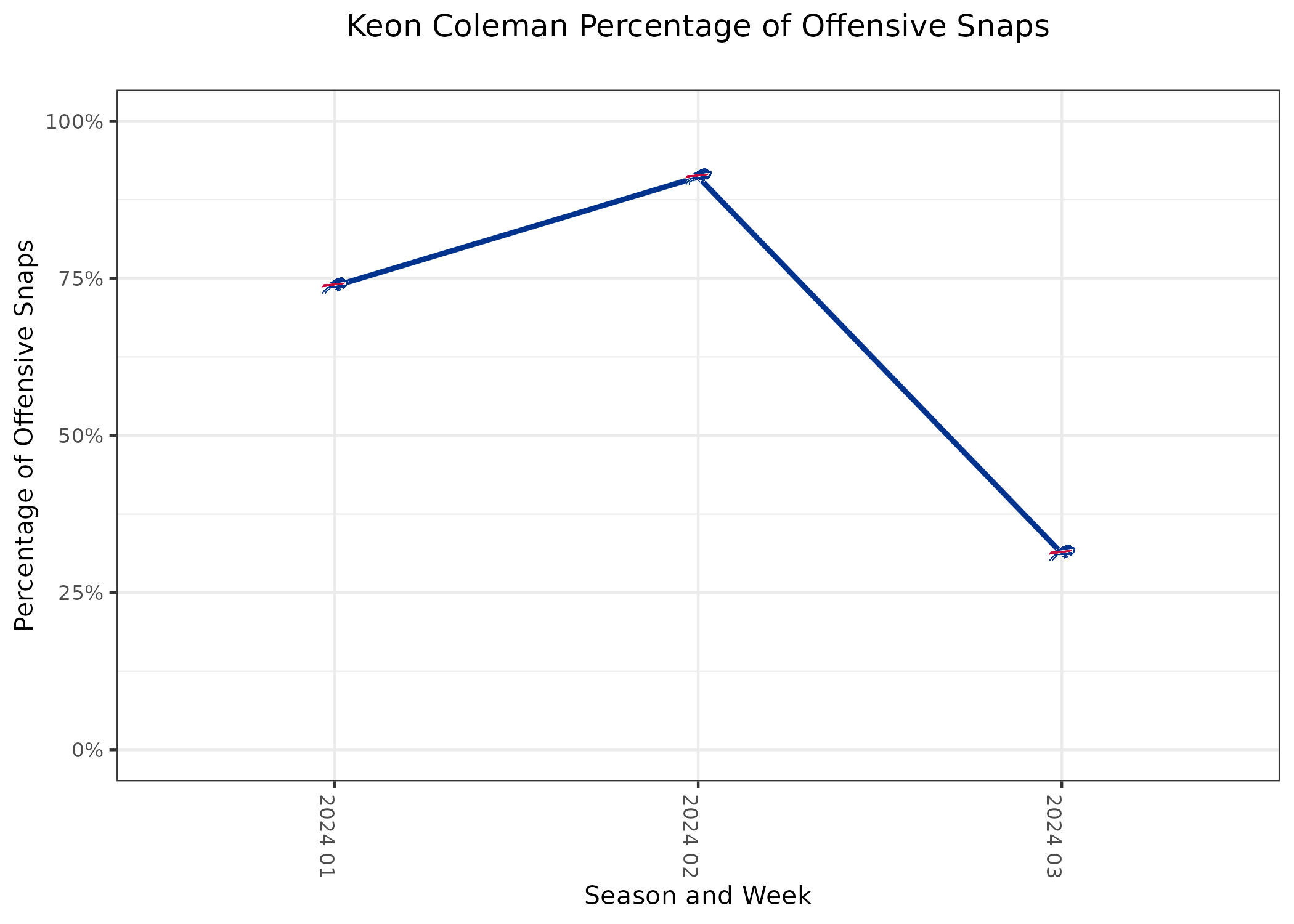
Dalton Kincaid’s usage remains a concern: Kincaid scored a touchdown and was one of the best tight ends of the week, but his playing time will prevent him from consistently performing well.
Throughout last season, Kincaid’s big concern was Dawson Knox and how much the two rotated. In Week 1, Kincaid played 84% of offensive snaps, which was the most for him in a game in which Knox also played. This was excellent news for Kincaid’s fantasy managers.
Over the past two weeks, his playing time has declined significantly. Part of that is simply the Bills blowing out their opponents, leading to more backups playing in the second half. However, isolating the first three drives of the past two games when the result of the game wasn’t guaranteed, Kincaid has played only 27 of 46 snaps. He has run a route on 16 of 31 pass plays, with Knox running a route on 17 of those plays.
Kincaid is one of the highest-graded tight ends in one of the best offenses, so he should still be in fantasy starting lineups despite the suboptimal usage, but it will be harder for him to finish the season as a top-five tight end if the Bills keep rotating him out so much.
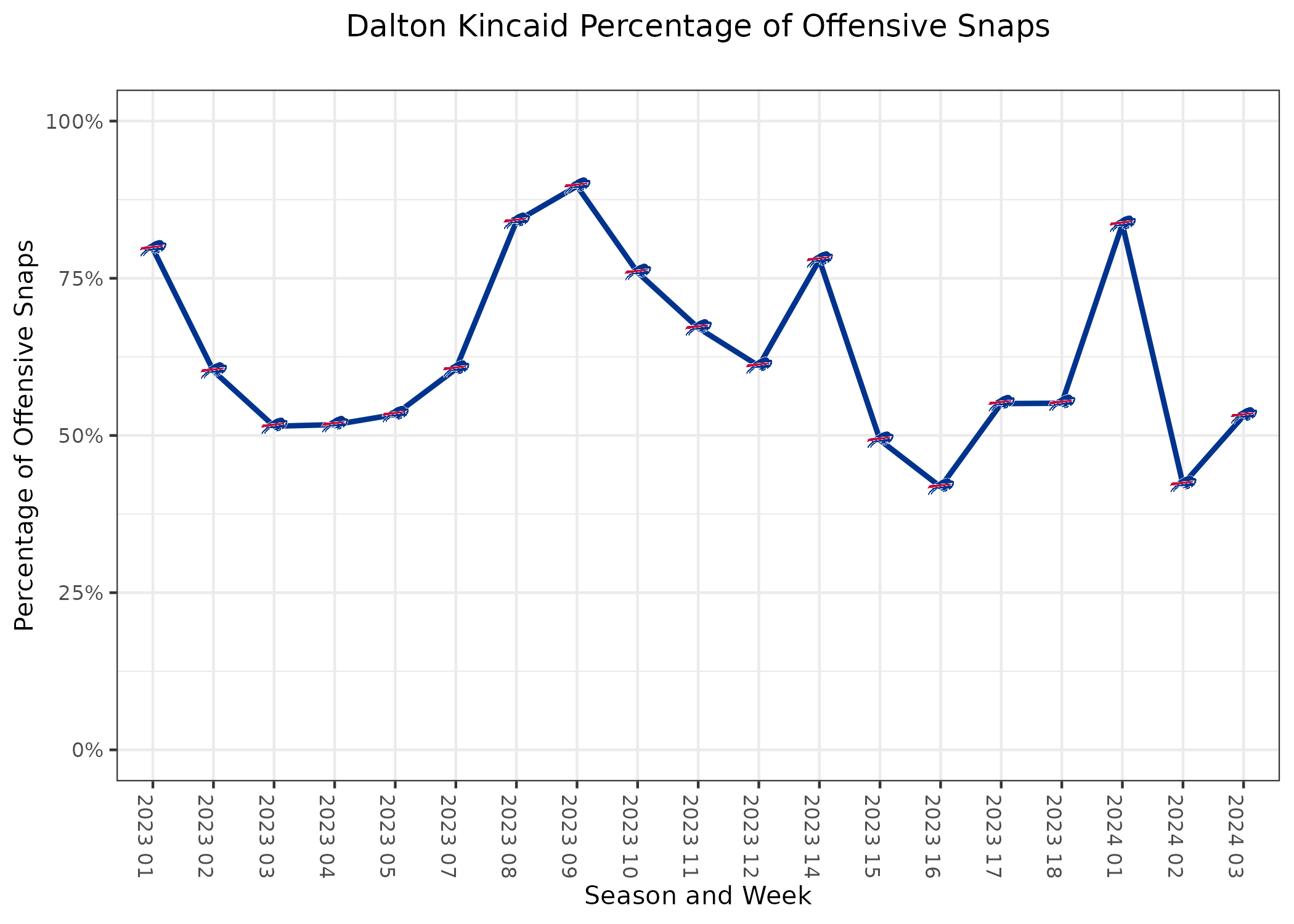
Brenton Strange continues to replace Evan Engram: Engram missed his second straight game with a hamstring injury.
Engram suffered his injury in pre-game warmups in Week 2, resulting in the Jaguars making changes to their plans on the fly. Strange basically took Engram’s role that week, with little change in the rotation.
This week, the Jaguars added Josiah Deguara from the practice squad so they could have three tight ends like usual. If anything, Strange saw more offensive snaps than Engram would have. The Jaguars had rotated Engram out more than usual with the starters in the preseason and Week 1. He was typically playing around 80% of snaps last season, but that was down to 68% in Week 1.
Strange caught two passes for 12 yards and a touchdown in Engram’s absence. If Engram continues to miss time, Strange should be considered one of the best waiver options at the position. He has a rare combination of playing time and target share. Strange was the 61st overall pick, so he could also be the tight end of the future in Jacksonville.
This also complicates the situation when Engram comes back. Considering the Jaguars’ 0-3 record, there could be a time when they start looking toward the future this season. That would mean more snaps for their 23-year-old tight end and less time for their 30-year-old tight end. Engram was drafted as a fantasy starter but could be in too much of a rotation to trust starting him.
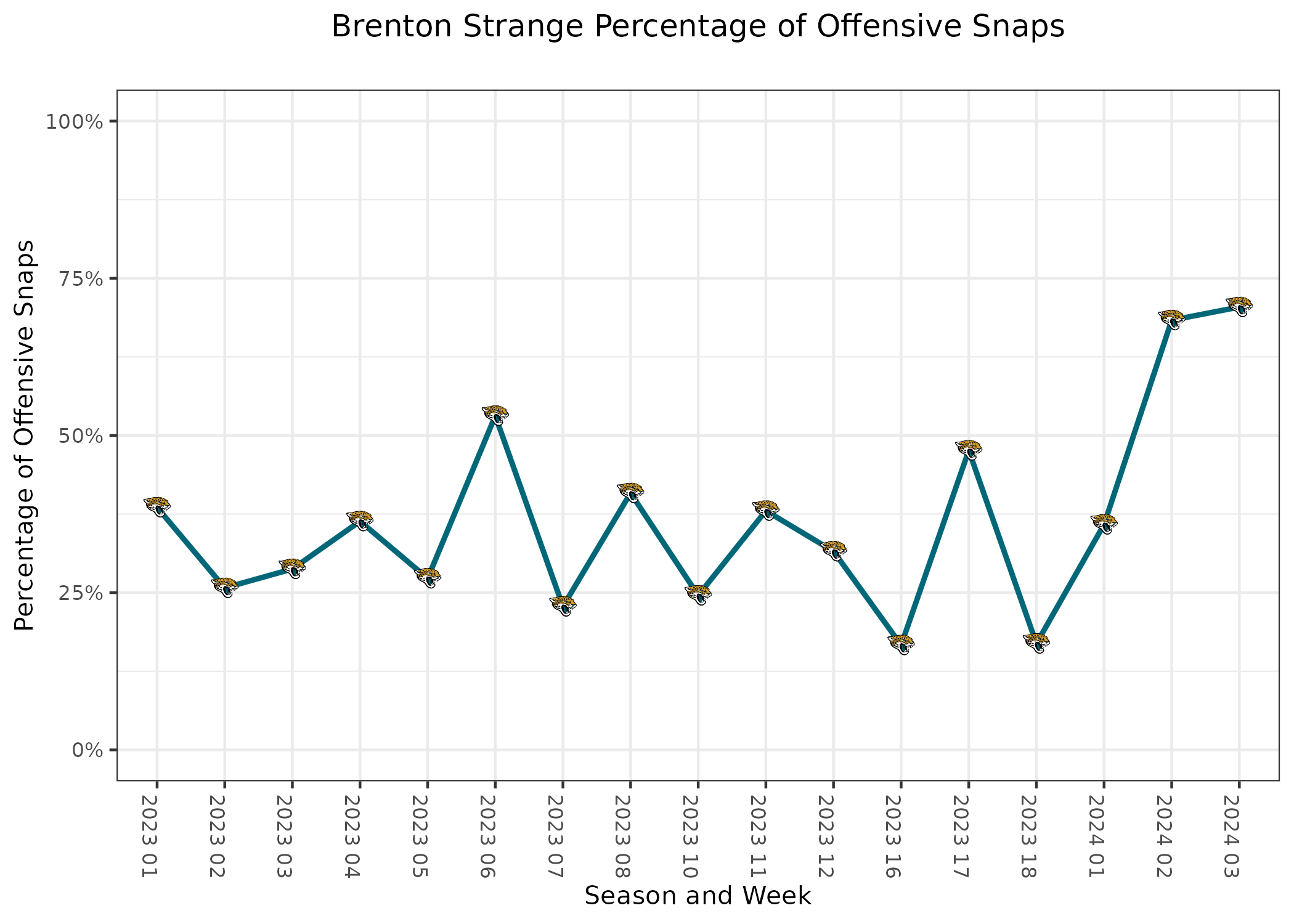
The Jaguars rotate their wide receivers more often: Parker Washington and Devin Duvernay rotated in more often than the first two weeks.
In 11 personnel, Washington rotated in a bit more for Gabe Davis and Brian Thomas Jr., resulting in both wide receivers seeing less playing time than usual. In contrast, both played more than usual in 12 personnel, leaving Christian Kirk rarely playing in that personnel grouping. Kirk, as a result, saw fewer snaps than usual. The game script kept the Jaguars passing and in 11 personnel, so Kirk’s decrease wasn’t as noticeable as that of the outside receivers.
These changes weren’t significant, but they did result in Washington recording as many receiving yards as Davis. This will be something to monitor going forward, but the Jaguars’ lack of offense, in general, is a lot more concerning than the slight changes in playing time.
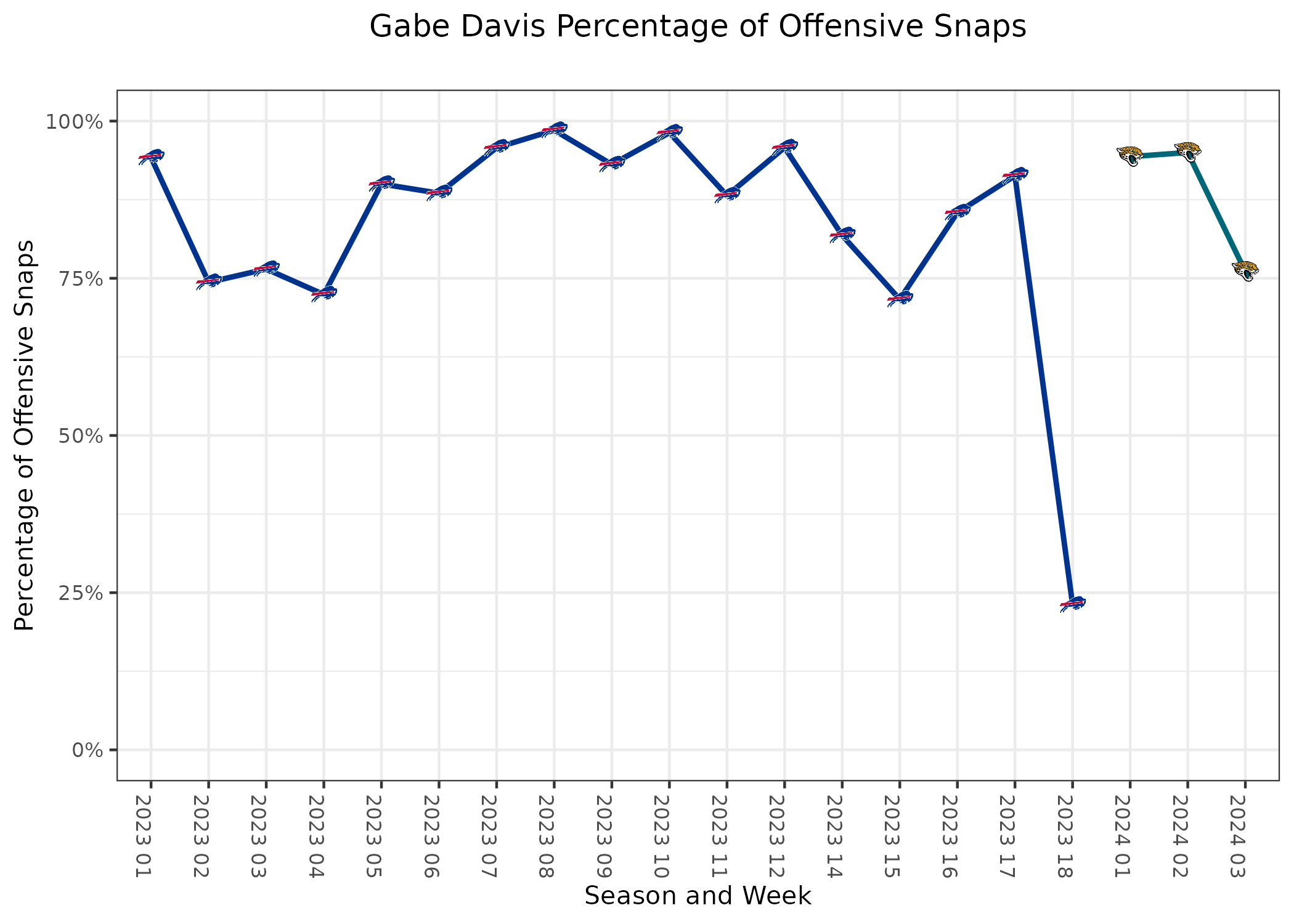
Miscellaneous Notes
• The Bills’ running back rotation was fairly normal this week prior to garbage time, except Ty Johnson took a higher percentage of the third-down snaps compared to the first two weeks.
• Tank Bigsby was questionable with a shoulder injury but returned to being the Jaguars’ primary backup. This is the first game of the season where all three running backs played on offense, but ultimately, Etienne played a normal number of snaps before garbage time.
• The Bills put in Mitch Trubisky with 10 minutes left in the game, and Mac Jones entered for the Jaguars with eight minutes left, which had a significant impact on playing time for some positions.
Washington Commanders @ Cincinnati Bengals
- Ja’Marr Chase: 6 receptions, 118 yards, 2 touchdowns
- Terry McLaurin: 4 receptions, 100 yards, 1 touchdown
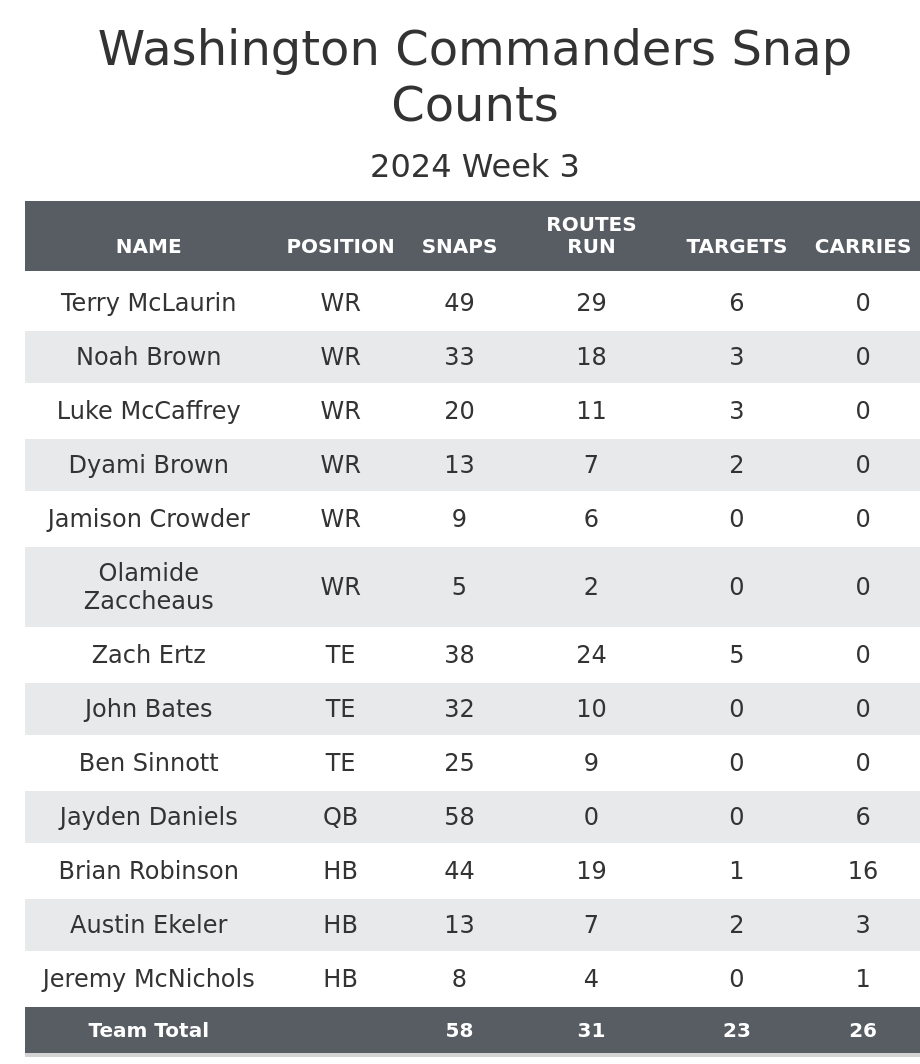
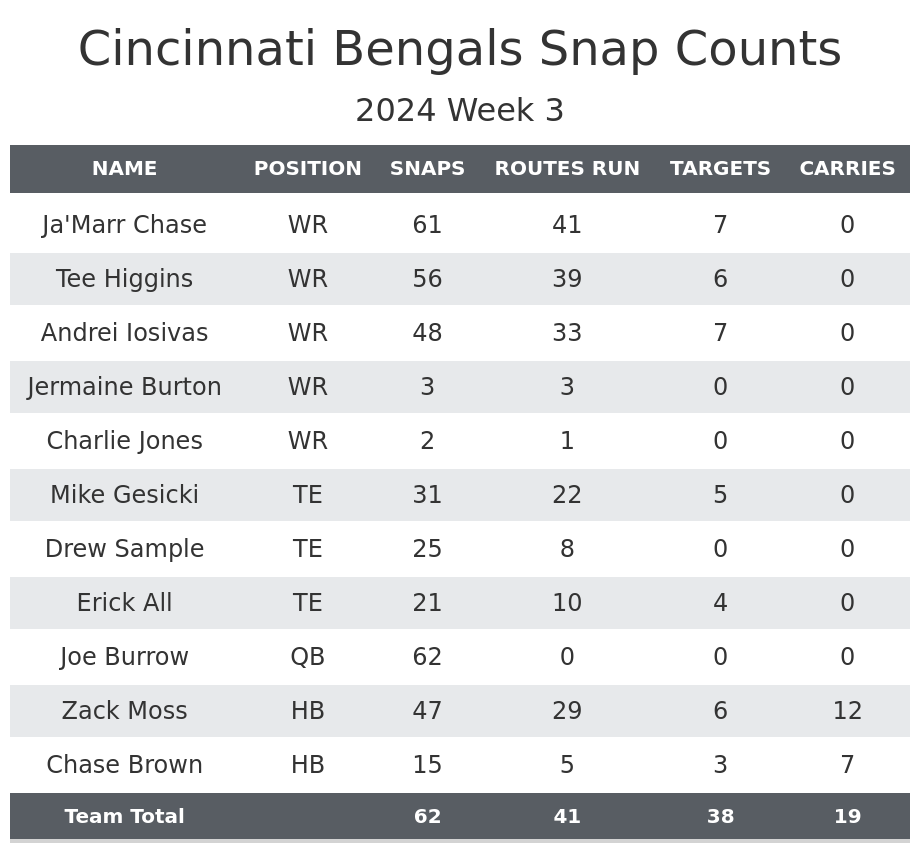
Monitor Austin Ekeler’s health: Ekeler suffered a concussion in the third quarter and didn’t return.
The Commanders started the game with five straight plays of having both Brian Robinson and Ekeler on the field. That occurred two more times in the first half, allowing both players to see more playing time than usual by halftime. Robinson played 19 of 25 snaps, while Ekeler logged 12.
In the second half, Ekeler played just one snap before leaving with the injury. This allowed Robinson to become the every-down back for Washington. Robinson was already averaging a respectable 16.3 PPR points per game before this week, but a low yards per carry resulted in his average decreasing despite the increased playing time.
If Ekeler misses any time, Robinson would go from a borderline fantasy starter to a must-start player.
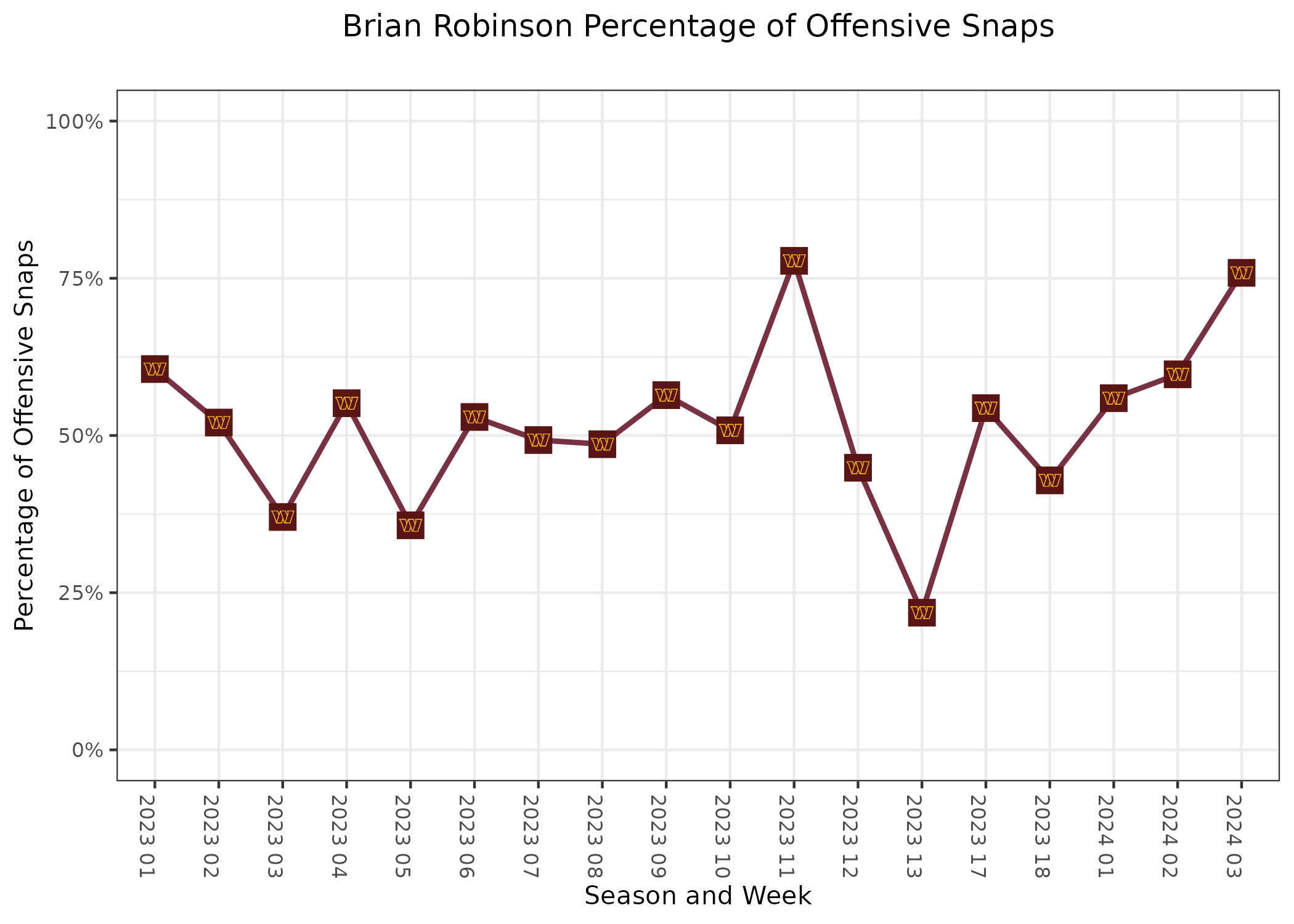
The Commanders figure out their wide receiver rotation: The Commanders rotated their wide receivers much less than in previous weeks or the preseason.
Throughout the preseason and in Week 1, Dyami Brown and Olamide Zaccheaus were battling for an outside receiver spot. Last week, Noah Brown entered that competition and caught three passes for 56 yards, which was enough to give him the starting job this week. Brown saw fewer snaps than only Terry McLaurin because McLaurin was consistently on the field in three-tight end sets and Brown wasn’t.
Luke McCaffrey was the clear slot receiver in 11 personnel in Week 1. Zaccheaus, after losing the outside wide receiver battle, received some slot work in Week 2. This week, the Commanders were back to giving McCaffrey the majority of the slot work. The three receivers were the top players in receiving yards for Washington against the Bengals.
It wouldn’t be surprising if the Commanders continue this usage going forward. This makes Noah Brown a waiver target in deeper leagues.
Tee Higgins returns for the Bengals: Higgins missed the first two weeks of the season with a hamstring injury.
In the past when Higgins was returning from an injury, he would often be on a snap count, but that wasn’t the case this week. He played his normal role, although he didn’t see as many targets as usual.
While he was gone, Andrei Iosivas played on the outside and Trenton Irwin featured in the slot. Irwin was a healthy inactive this week, allowing young wide receivers Jermaine Burton and Charlie Jones to remain the primary backups. Iosivas moved to be the primary slot receiver for Cincinnati, with Chase also seeing more time in the slot.
The move also benefited Chase because it meant Washington couldn’t double-cover him as much as past defenses have. Going forward, Chase can be trusted more to finish in the top 10, whereas Higgins will be a borderline fantasy starter until his target share increases.
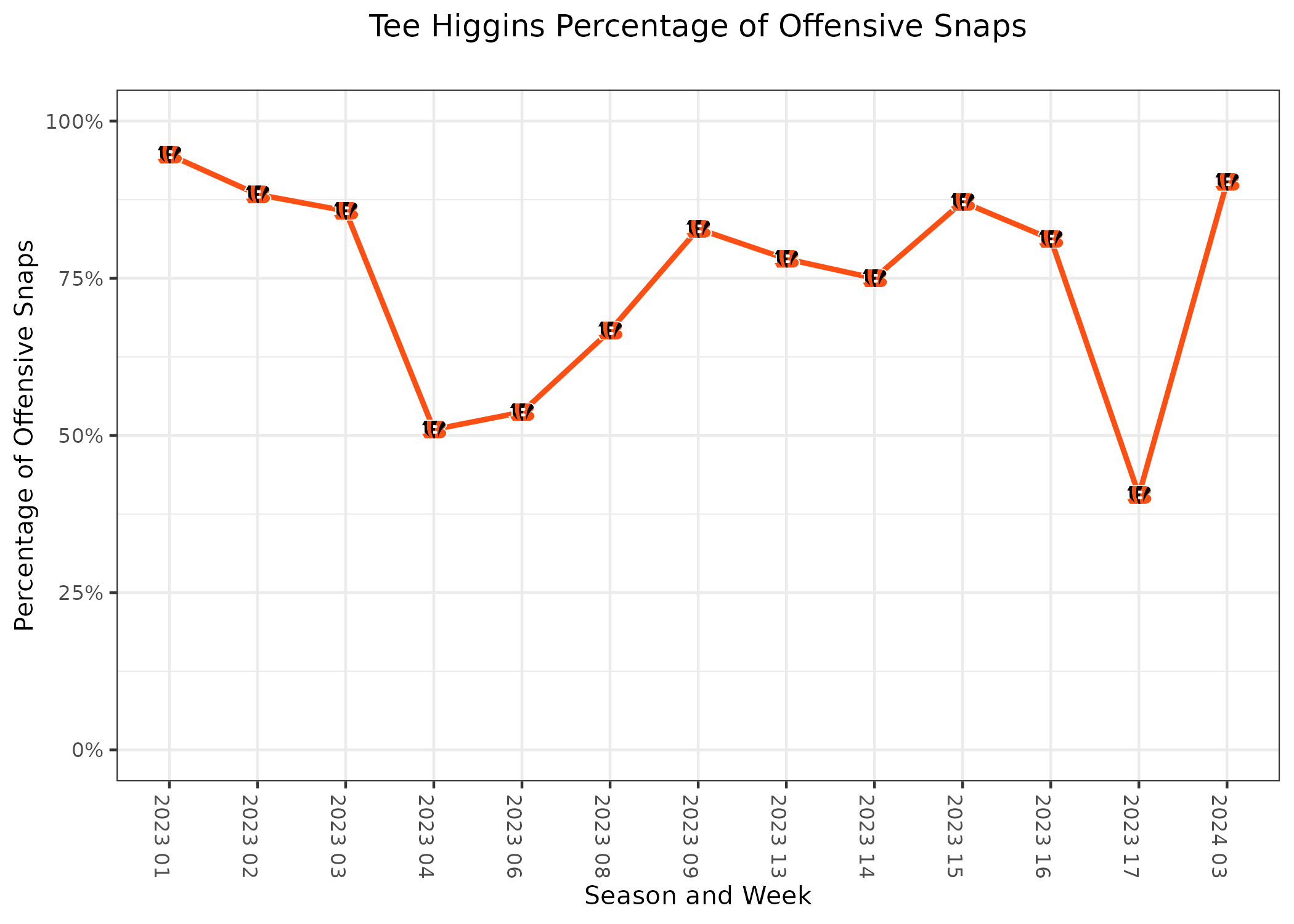
Chase Brown leads the Bengals in rushing: Brown ran seven times for 62 yards.
The Bengals’ running back rotation was exactly the same as last week. Zack Moss was the clear primary running back in every situation, with Brown mixing in a little bit throughout. The only difference this week is that Cincinnati ran more than they had the first two weeks when Brown was on the field.
Both Brown and Moss were more effective running the ball in Week 3 than in the first two weeks. They each notched runs of 15-plus yards and averaged more than five yards per carry. Brown just had more big gains, leading to more yards despite fewer carries. It will take the Bengals leading in a game for either running back to reach their true potential. It will be worth monitoring if Brown earns more playing time after this strong performance.
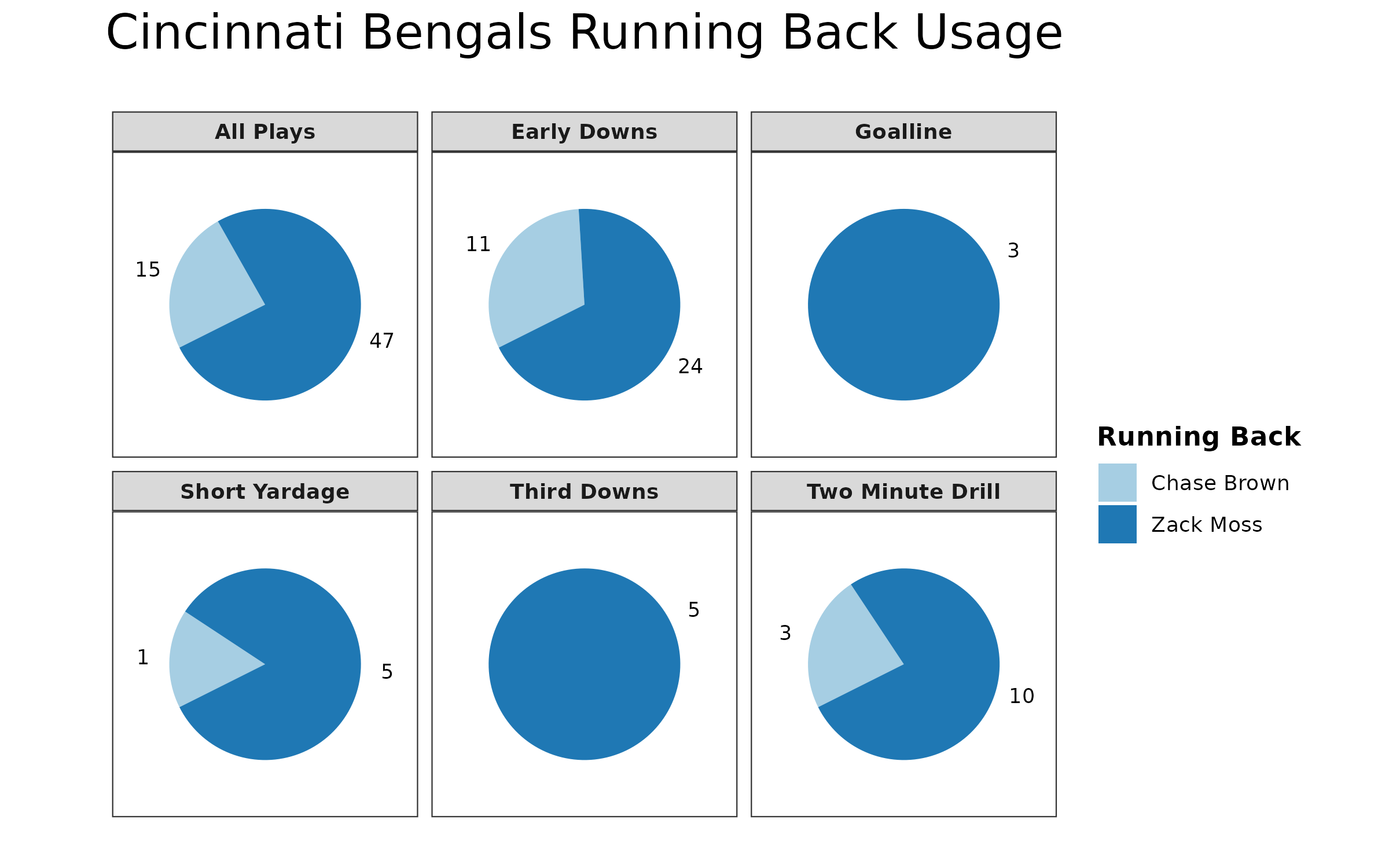
Miscellaneous Notes
• The Commanders followed a similar tight end rotation as the first two weeks, with Zach Ertz as the primary tight end in 11 and 21 personnel and John Bates and Ben Sinnott as the primary tight ends in 12 personnel. The big difference this week is that Ertz played only one snap in 12 personnel after taking half the snaps there in Week 1 and a few in Week 2.
• The Bengals’ tight end rotation continued. There was a general tendency of Mike Gesicki in 11 personnel and Drew Sample and Erick All in 12 personnel, but those trends are less reliable than most teams with a rotation.
• Bengals backup receiving tight end Tanner Hudson missed his second straight game with a knee injury. Once he’s back, he will likely further complicate the tight end rotation.
Table Notes
• Snaps include plays called back due to penalties, including offensive holding or defensive pass interference. The other three stats have these plays removed.
• Targets may differ from official NFL sources. The most likely discrepancy would be from a clear thrown-away pass, where the NFL may give the target to the nearest receiver while this data will not.
• Carries are only on designed plays. Quarterback scrambles won’t count for the total number of carries in the game.




 © 2024 PFF - all rights reserved.
© 2024 PFF - all rights reserved.